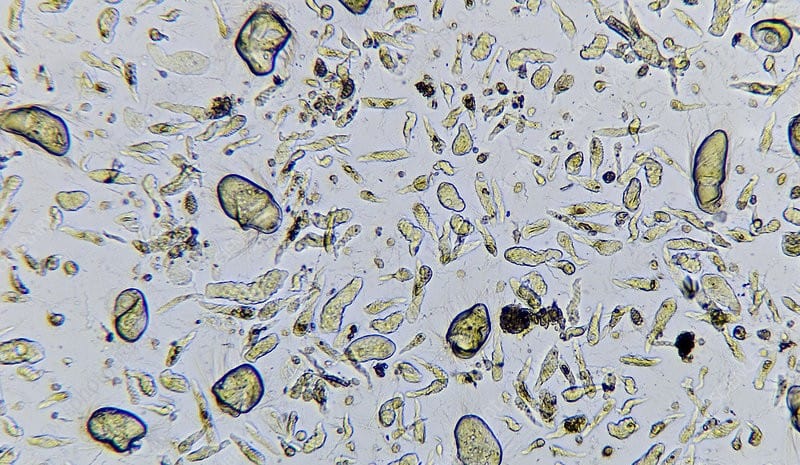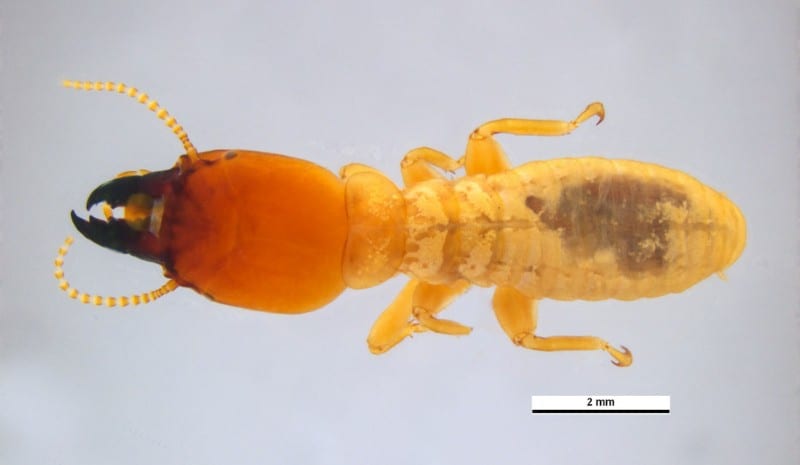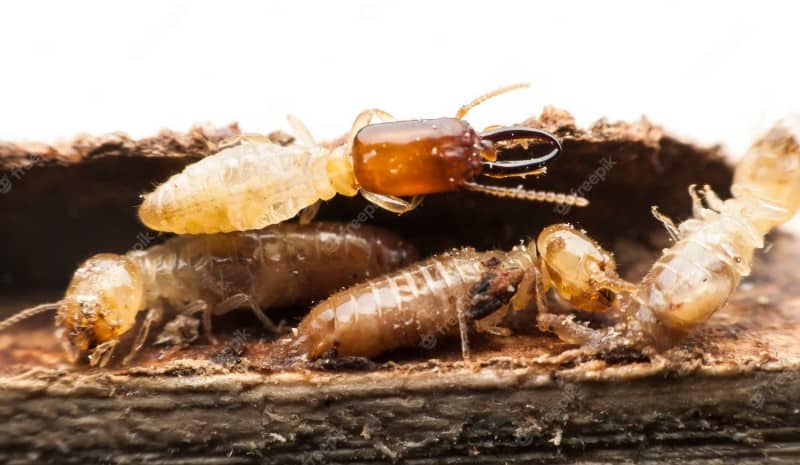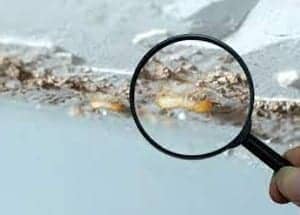Gut Microbes in Termites
Termites are small insects that inhabit almost every corner of the world. Some people consider them as a nuisance, while others see them as extremely helpful creatures. Gut microbes in termites play a critical role in termite digestion, allowing them to break down complex plant fibers, which facilitates their survival. As termites consume various plant substrates, they have developed a mutually beneficial relationship with these microbes. Let’s take a closer look at how gut microbes contribute to the eating habits and survival of termites, and how the relationship between termites and gut microbes is continually being studied and analyzed. To learn more about the termite diet and feeding patterns, check out this article.

What Are Gut Microbes?
Gut microbes are microorganisms that live in the intestines of termites. These microorganisms play a crucial role in termite digestion and are known to be essential for their survival. The majority of gut microbes in termites are bacteria, although archaea, fungi, and protozoa are also present.
The termite gut microbes are classified into two groups:
| Obligate gut symbionts | Facultative microbes |
|---|---|
| Their presence is necessary for the survival of the termite. | They can survive both inside and outside the termite’s gut environment. |
| They have a highly specialized and co-evolved relationship with their host. | They are not specific to the termite gut and can be found in other environments. |
| They are present in all members of the termite colony. | They can vary in their composition and abundance within the gut of different termites. |
The gut microbes in termites have several functions in termite digestion. They break down complex molecules such as lignocellulose, hemicellulose, and pectin into simple compounds that can be easily digested by termites. These microbes also produce enzymes that are involved in the digestion of proteins and lipids.
The presence of gut microbes in termites allows them to survive on a diet that would otherwise be nutritionally insufficient. Termites feed on a variety of cellulose-containing materials such as wood, grass, and soil, which are difficult for other animals to digest. The presence of gut microbes in termites allows them to break down cellulose and extract nutrients from their food.
Gut microbes are microorganisms that live in the intestines of termites and are essential for their survival. They have several functions in termite digestion, including breaking down complex molecules and producing enzymes that aid in the digestion of proteins and lipids. Without gut microbes, termites would not be able to survive on their diet of cellulose-containing materials such as wood.
The Benefits of Gut Microbes in Termites
Gut microbes play a crucial role in the survival of termites. They live in the hindgut region of the termite’s digestive tract and help in breaking down and digesting complex organic compounds, such as cellulose, hemicellulose, and lignin, which are present in wood and plant material. The benefits of gut microbes in termites can be summed up as follows:
1. Enhanced Nutrient Acquisition: Termites lack the necessary enzymes to break down these complex compounds by themselves. Gut microbes, in turn, produce these enzymes, improving the termite’s ability to extract nutrients from its diet.
2. Resistance to Environmental Stressors: Gut microbes in termites also help in maintaining a stable environment in the hindgut, which helps in reducing the toxic effects of metabolites that accumulate as a result of wood digestion. This, in turn, helps the termites remain healthy and resistant to environmental stressors.
3. Efficient Digestion: The presence of gut microbes enables termites to digest wood efficiently, which is essential for their survival and growth.
4. Mutualistic Relationship with Termites: The relationship between termites and gut microbes is mutualistic. Termites provide a habitat for the gut microbes, while the microbes help the termites digest their food.
5. Contribution to Ecosystem Functioning: Gut microbes in termites also have important implications for ecosystem functioning, as they play a significant role in the breakdown of organic matter. This, in turn, affects soil fertility and nutrient cycling.
Understanding the benefits of gut microbes in termites is essential in developing effective strategies for termite control and managing their impact on ecosystems. By studying the interactions between termites and their gut microbes, researchers can develop more targeted and sustainable approaches to termite control that take advantage of the beneficial roles of gut microbes. To learn more about termite diets and feeding patterns, you can read our article here.
The Digestive System of Termites

Termites are known for their unique digestive system, which is able to break down and digest cellulose – a complex carbohydrate found in plant matter that other animals cannot digest. This system relies heavily on a diverse community of gut microbes that work together to perform various functions in digestion.
The Digestive Process: Termites have a two-step process for digesting cellulose. First, they ingest wood or other plant material through their mandibles, which is then broken down into smaller pieces in the foregut. These smaller particles are then passed to the hindgut, where the gut microbes take over.
The Role of Gut Microbes: The gut microbes in termites play a crucial role in breaking down cellulose. They secrete a variety of enzymes that break apart the complex cellulose molecules into simpler sugars that can be absorbed by the termite. Some of the gut microbes also produce fermentation products like hydrogen and acetate, which the termite can use as an energy source.
The Composition of the Gut Microbiome: The gut microbiome in termites is made up of a variety of microorganisms such as bacteria, protozoa, and fungi. These microbes are specialized to perform different functions in digestion, and different termite species have different gut microbial communities.
The Importance of Gut Microbes: Without their gut microbes, termites would not be able to digest cellulose and would starve. This reliance on gut microbes also means that termite control strategies that target the gut microbiome could be an effective way to control termite populations.
The digestive system of termites is a fascinating and complex process that relies heavily on the diverse and specialized community of gut microbes. To learn more about what termites eat, check out our article on termite feeding patterns.
The Latest Research Findings
The fascinating world of termite microbiology is constantly evolving with groundbreaking research and numerous exciting discoveries. Recently, research has focused on the role of gut microbes in termite digestion. It has been found that these tiny organisms have a significant impact on the diet and behavior of termites. Let’s explore the latest research findings and how they shed light on the intricate relationship between gut microbes and termites, ultimately leading to a better understanding of termite ecology and management strategies.
The Diversity of Gut Microbes in Different Termite Species
The gut microbes present in termites are a crucial aspect of their digestive system. Interestingly, the diversity of these gut microbes varies greatly between different termite species.
Table: Diversity of Gut Microbes in Different Termite Species
| Termite Species | Gut Microbes Present |
|---|---|
| Subterranean Termites |
|
| Dampwood Termites |
|
| Drywood Termites |
|
For example, subterranean termites have a different composition of gut microbes than dampwood or drywood termites. Subterranean termites have cellulolytic bacteria, spirochetes, fibrobacter, and proteobacteria present in their gut – all of which aid in different aspects of digestion. In comparison, dampwood termites have bacteroidetes, actinobacteria, and firmicutes, while drywood termites have tenericutes, proteobacteria, and firmicutes. These differences in gut microbes can be attributed to the differences in the diets of these termite species.
Understanding the diversity of gut microbes in different termite species is essential when investigating novel pest control strategies. By developing a deeper understanding of the digestive processes of termites, researchers can identify potential avenues for targeted disruption of the termite’s ability to convert wood into energy.
If you’re interested in learning more about termite diets and feeding patterns, check out our articles on subterranean termite diet, termite feeding patterns, and drywood vs dampwood termites .
The Genomic Insights into the Functions of Gut Microbes
Recent studies have shown that genomic research has provided significant insights into the functions of gut microbes in termites. The genomes of several termite species have been sequenced, allowing scientists to map the genes and enzymes involved in termite digestion.
The diverse functions of gut microbes: The genomic analysis of gut microbes has revealed the diverse range of functions they perform in the digestive system of termites. For instance, some gut microbes are responsible for the breakdown of cellulose, a complex carbohydrate present in wood and plant material. Other gut microbes are involved in the processing of nitrogenous compounds, while some specialize in the production of essential fatty acids. The specific mix of gut microbes present in different termite species and castes is tailored to their specific dietary needs, further highlighting the importance of these microbes in termite digestion.
The discovery of novel enzymes: Genomic analysis has allowed researchers to identify novel enzymes produced by gut microbes that could have numerous potential applications in various industries. For example, an enzyme discovered in the gut of termites, called a xylanase, could be used to break down plant material into simple sugars, which can then be used to produce biofuels.
The evolution of termite gut microbes: Genomic research has also provided insights into the evolutionary history of gut microbes in termites. For example, it has been found that gut microbes have co-evolved with termites, adapting to changes in their diets and environments over millions of years. The genetic diversity of gut microbes in different termite species points towards a pattern of horizontal gene transfer, where microbes share genes and genetic material with other species, including those from entirely different kingdoms, such as bacteria and archaea.
These genomic studies have shed light on the complex and dynamic relationships between termites and their gut microbes. As we continue to expand our understanding of these microbiomes, there is potential for promising breakthroughs in industries such as biotechnology and bioenergy.
The Interactions between Gut Microbes and Hosts

The interactions between gut microbes and hosts are complex and multifaceted. Research has shown that termites and their gut microbes have a symbiotic relationship in which they both benefit from one another. Termites provide a suitable environment for their gut microbes to thrive, while the gut microbes aid in the breakdown of cellulose and other otherwise indigestible components of the wood that termites consume.
1. The gut microbes aid in termite digestion
The gut microbes in termites play a critical role in the digestion process. Termites are not able to digest cellulose on their own, but with the help of their gut microbes, they can extract the energy they need from the wood they consume. In fact, the gut microbes are responsible for breaking down up to 60% of the wood that termites ingest. This symbiotic relationship has allowed termites to successfully colonize diverse ecological niches.
2. The host provides a suitable environment for gut microbes
Termites provide a unique and beneficial environment for their gut microbes to thrive. The termite gut provides a protective and stable environment where microbes can break down tough plant materials. The gut pH, temperature, and nutrient availability are carefully controlled by the termite host to ensure optimal conditions for their gut microbes to grow and function.
3. Physical and chemical interaction between microbes and hosts
Gut microbes interact closely with the host and other microbes through physical and chemical mechanisms. Research has shown that a variety of signaling molecules are exchanged between termites and their gut microbes. These molecules play a role in regulating the activity of the microbes and the host, helping to maintain the symbiotic relationship. Additionally, physical interactions between gut microbes and host cells have been observed, leading to speculation that the microbes may play additional physiological roles outside of digestion.
The interactions between gut microbes and hosts in termites are a fascinating area of research that is yielding important insights into the workings of symbiotic relationships. As scientists continue to investigate this topic, new findings may lead to novel approaches to termite control. To learn more about termite digestion and cellulose nutrition, check out our article on /termite-cellulose-nutrition/ and for information on termite landscape modification, read our article on /termite-landscape-modification/.
The Future of Termite Control
As termite infestations continue to pose a threat to homes and property, researchers are exploring new ways to control these invasive pests. While traditional methods such as insecticides have been effective, they also come with potential risks to human health and the environment. As a result, the future of termite control looks towards more natural and sustainable solutions. In this section, we’ll explore how gut microbes in termites can play a crucial role in developing novel pest control approaches, and examine the ethical considerations that come with using these methods. So, what could the future of termite control look like? Let’s dive in and find out.
The Role of Gut Microbes in Developing Novel Pest Control Approaches
Gut microbes have been found to play an important role in termite digestion, but did you know that they can also be used in developing novel pest control approaches?
One example is through the use of probiotics, which contain beneficial gut microbes that can help prevent the growth of harmful bacteria in pests. By introducing these beneficial microbes in the pests’ environment, they can outcompete and crowd out the pathogenic microbes, leading to a reduction in pest populations.
Another approach is through the manipulation of gut microbiota, which involves altering the composition of gut microbes in pests to disrupt their natural digestive processes. This can be done through the use of antibiotics or other agents that target specific gut microbes.
A third approach is the genetic modification of gut microbes to enhance their efficacy in controlling pest populations. This involves identifying specific genes in gut microbes that are responsible for their beneficial effects, and then manipulating those genes to improve their performance.
While these approaches show promise in developing novel pest control methods, there are still many challenges that need to be addressed. For example, the effects of introducing foreign gut microbes into an ecosystem are not yet fully understood, and there is a risk of unintended consequences. Additionally, ethical concerns need to be considered when manipulating the natural microbial communities of pests.
Nevertheless, the potential benefits of utilizing gut microbes in pest control are significant, and further research in this area may lead to the development of innovative and sustainable pest management strategies.
To summarize:
| Approach | Description | Challenges |
| Probiotics | Introducing beneficial gut microbes to outcompete harmful microbes | Long-term effects and potential unintended consequences |
| Manipulation of gut microbiota | Altering the composition of gut microbes to disrupt natural digestive processes | Risk of unintended consequences |
| Genetic modification | Manipulating the genes of gut microbes to improve their efficacy | Ethical concerns and potential long-term effects |
The Ethical Considerations in Using Gut Microbes in Pest Control
As with any new technology or approach to pest control, there are important ethical considerations to take into account when considering the use of gut microbes. While there is no doubt that they can be effective at controlling termite populations, we must consider the potential long-term effects of their use on both the environment and on the termites themselves.
Table: Potential Ethical Considerations in the Use of Gut Microbes in Termite Control
| Issue | Explanation |
| Environmental impact | The use of gut microbes could potentially have unintended consequences on non-target species in the environment, as well as on soil health and biodiversity. |
| Efficacy | The long-term efficacy of gut microbes as a form of pest control is still unknown, and the risk of resistance developing over time should be considered. |
| Termites as a keystone species | Termites play an important role in many ecosystems as decomposers, and their removal could have unforeseen consequences on the balance of these ecosystems. |
| Animal welfare | The use of a living organism as a form of pest control raises questions about animal welfare and the treatment of these organisms. |
| Impact on the food chain | Controlling termite populations could have unforeseen effects on animals higher up in the food chain that rely on termites as a food source. |
| Public perception | The use of gut microbes in pest control could be perceived as controversial or unnatural, and may not be widely accepted by the general public. |
It is important to carefully weigh these potential ethical considerations against the benefits of using gut microbes in termite control. While they may be an effective form of control in some situations, we cannot ignore the potential risks and implications of their use. It may be necessary to find alternative methods of pest control that are less controversial and have fewer unintended consequences. As with any new technology or approach to pest control, continued research and evaluation will be necessary to fully understand the long-term impacts of using gut microbes in termite control.
Conclusion
In conclusion, the study of gut microbes in termite digestion has led to significant breakthroughs in our understanding of these fascinating creatures. The complex relationship between termites and their gut microbiota highlights the importance of bacteria in the biological diversity and ecological balance of our planet. By unlocking the secrets of how termite guts work, researchers may uncover new ways to address global challenges, such as crop protection and the development of sustainable biofuels.
Further Research Is Needed
While our knowledge of gut microbes in termites has advanced in recent years, there is still much to learn. Future research may focus on the development of new techniques for studying these microscopic creatures, as well as investigating the factors that affect their diversity and function. Additionally, more research is needed to assess the potential of gut microbes in pest control and identify any potential risks associated with their use.
The Importance of Ethical Considerations
As with any new technology or approach to pest control, it is essential to consider the ethical implications of using gut microbes in this context. Any new approach must take into account the welfare of the animals involved, as well as the potential impact on the wider environment. Current regulations may need to be updated to reflect the latest scientific advances and ensure that they are used only for the benefit of humankind.
The Promise of Gut Microbes
Overall, the study of gut microbes in termite digestion offers a wealth of opportunities for advancing our understanding of these fascinating creatures. By shedding light on the complex relationships between termites and their gut bacteria, we may be able to develop new pest control strategies and contribute to the wider understanding of our planet’s ecosystems. While challenges remain, the future of gut microbe research in termite digestion looks promising, and we can expect to see exciting new developments in this field in the years to come.
Frequently Asked Questions
What are gut microbes?
Gut microbes, or gut flora, are microorganisms that live in the digestive tract of various animals, including termites. These microorganisms play important roles in digestion and nutrient absorption.
How do gut microbes benefit termites?
Gut microbes help termites break down cellulose, a main component of plant cell walls, which provides them with the energy they need to survive. Without gut microbes, termites would not be able to digest cellulose and would die.
What is the digestive system of termites like?
Termites have a unique digestive system that consists of multiple chambers called the foregut, midgut, and hindgut. Each chamber is filled with different gut microbes that aid in digestion.
How do gut microbes impact pest control strategies?
Gut microbes could potentially be used in the development of novel pest control strategies, as they play a crucial role in the survival of termites. However, more research is needed to fully understand their potential in this area.
What is biocontrol?
Biocontrol is the use of living organisms to control pests. Gut microbes have the potential to be used in biocontrol strategies as they can help prevent the growth and spread of harmful pest populations.
What is the diversity of gut microbes in different termite species?
Gut microbiomes can vary greatly between termite species based on their diet and geographic location. Research is ongoing to determine the diversity of gut microbes in different termite populations.
What are the genomic insights into the functions of gut microbes?
The study of the genomes of gut microbes can provide insights into their functions and how they aid in digestion, helping researchers understand their potential as pest control agents.
How do gut microbes interact with their hosts?
Gut microbes and their hosts have a symbiotic relationship – the gut microbes aid in digestion and nutrient absorption for the host while receiving a nutrient-rich environment to live in. Research is ongoing to understand the specifics of these interactions.
What is the role of gut microbes in developing novel pest control approaches?
Gut microbes have the potential to play a crucial role in the development of new pest control strategies. Researchers are exploring the possibilities of using gut microbes to target harmful pest populations while preserving other beneficial organisms.
What are the ethical considerations in using gut microbes in pest control?
As with any application of science and technology, the use of gut microbes in pest control raises ethical considerations. These must be fully explored before any applications are made to ensure that the benefits outweigh any potential risks or unintended consequences.

